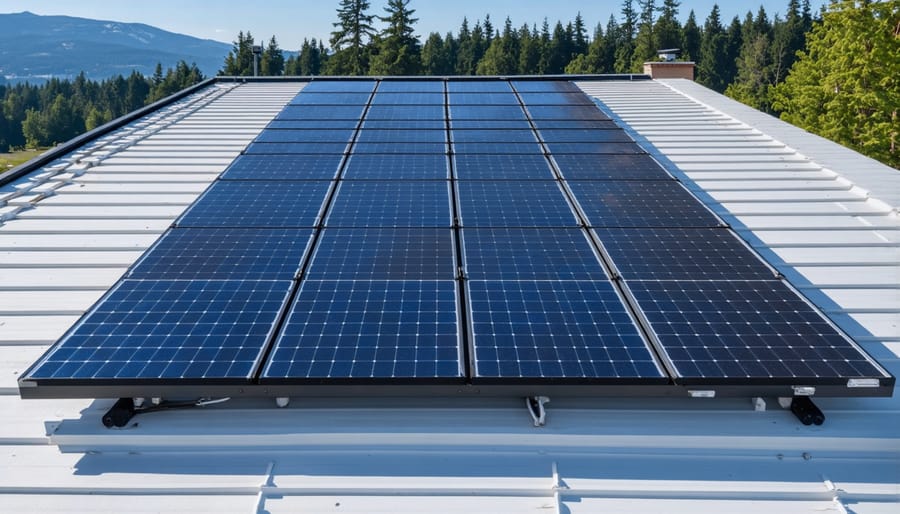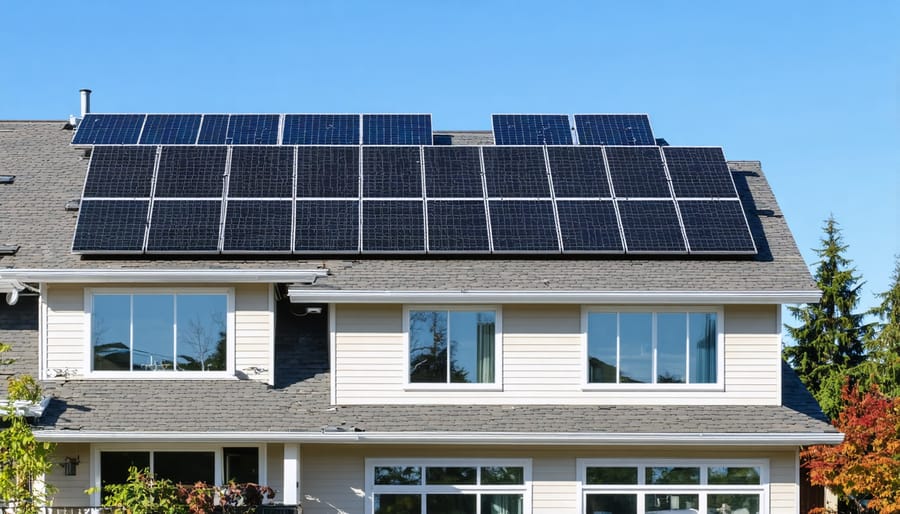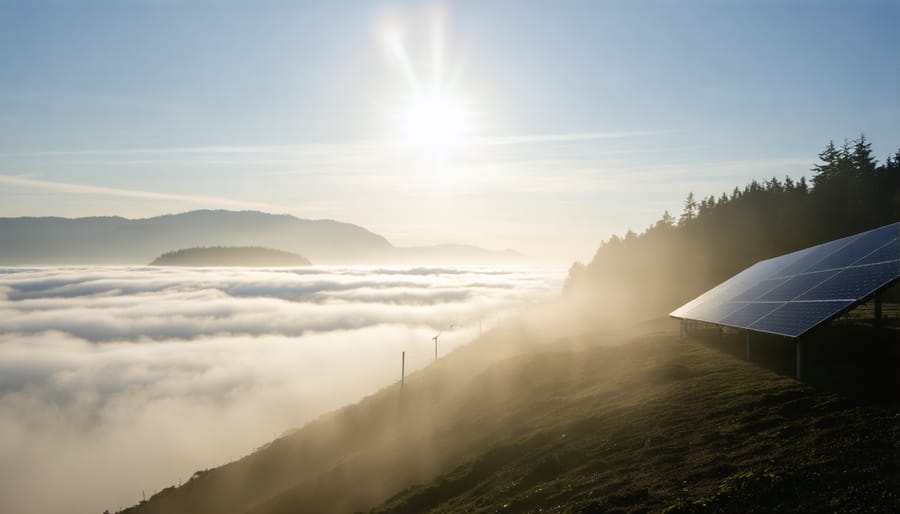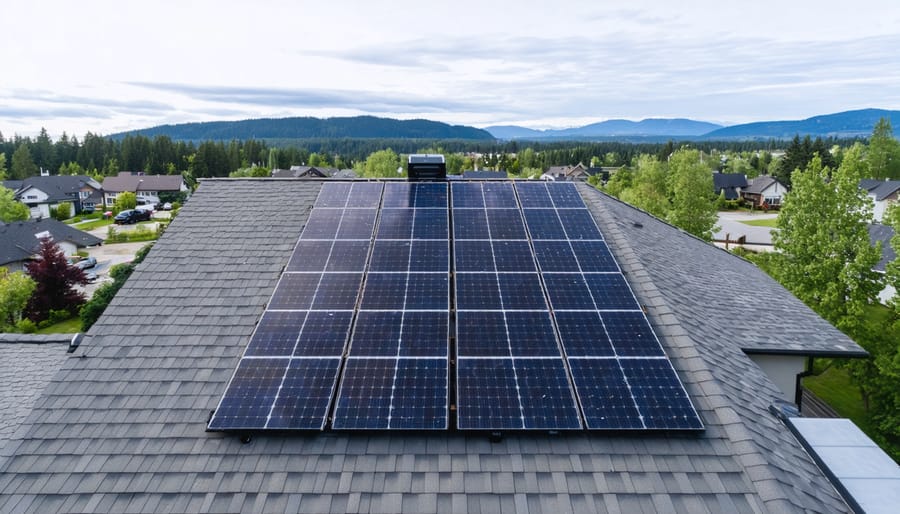Calculate your home’s daily energy consumption from your BC Hydro bill before sizing solar panels – most British Columbia homes require between 4,000 and 12,000 kilowatt-hours annually. Measure your available roof space, factoring in that each kilowatt of solar capacity needs about 100 square feet of unshaded area facing south, southeast, or southwest.
A typical 6kW residential solar system in BC, consisting of roughly 20 panels, can generate 6,000-7,200 kWh annually – enough to offset 70-80% of an average household’s electricity usage. Your specific needs depend on several critical factors: current energy consumption patterns, roof orientation, local weather patterns, and available installation space.
For most single-family homes in British Columbia, a solar array between 4kW and 8kW provides optimal coverage while maximizing available incentives and maintaining reasonable installation costs. This typically translates to 12-24 panels, depending on the specific model’s efficiency rating and your home’s energy requirements.
Smart sizing of your solar system now ensures optimal performance for decades while maximizing your return on investment through BC’s net metering program and available rebates.
Understanding Your Home’s Energy Needs
Calculate Your Monthly Power Usage
To accurately size your solar panel system, start by calculating your monthly power usage. Begin by gathering your BC Hydro bills from the past 12 months – this will help account for seasonal variations in your average household energy consumption.
Look for your monthly kilowatt-hour (kWh) usage on each bill and record these numbers. Add them together and divide by 12 to find your monthly average. For example, if you use 12,000 kWh annually, your monthly average would be 1,000 kWh.
Pay special attention to winter months when usage typically peaks due to heating needs, and summer months when air conditioning might increase consumption. Also note any planned changes that could affect your future usage, such as:
– Adding new appliances
– Converting to electric heating
– Purchasing an electric vehicle
– Home renovations or additions
– Energy efficiency upgrades
Keep in mind that your goal might be to offset all or just a portion of your electricity usage. This calculation will serve as the foundation for determining your ideal solar panel system size.
Account for Seasonal Variations
In British Columbia, solar panel production varies significantly throughout the year due to our distinct seasonal patterns. During summer months (June to August), you can expect peak solar generation with up to 18 hours of daylight. However, winter months (November to February) see reduced production with shorter days and increased cloud cover, typically generating about 25-30% of summer capacity.
To account for these variations, it’s important to size your system based on your annual energy needs rather than monthly averages. Many BC homeowners choose to slightly oversize their summer system to compensate for winter shortfalls. For example, a system that produces excess power in July can bank credits with BC Hydro’s net metering program, which you can use during darker winter months.
Consider tracking your energy consumption across all seasons before finalizing your solar panel size. Most BC homes use more electricity in winter for heating and lighting, precisely when solar production is lowest. Installing a monitoring system can help you understand these patterns and optimize your solar setup accordingly.

Available Roof Space and Solar Potential
Measuring Your Usable Roof Area
Before diving into solar panel calculations, you’ll need to measure your available roof space accurately. Start by examining your roof’s orientation – south-facing sections are ideal in British Columbia, though southeast and southwest facings can also work well. Using a measuring tape, determine the length and width of your usable roof area, making sure to exclude spaces around chimneys, vents, and skylights.
For a quick estimate, you can use satellite imagery tools like Google Earth to measure your roof dimensions. However, for precise measurements, we recommend having a professional solar installer conduct an on-site assessment. They’ll not only measure the space but also evaluate your roof’s pitch and structural integrity.
Remember to consider shading from nearby trees, buildings, or other obstructions. In BC’s varied landscape, factors like tall evergreens or neighboring structures can significantly impact solar panel efficiency. A good rule of thumb is to avoid installing panels in areas that receive shade during peak sunlight hours (typically 10 AM to 2 PM).
Most residential solar panels measure approximately 65 by 39 inches, requiring about 17.5 square feet per panel. For example, if you have 500 square feet of usable roof space, you could potentially accommodate up to 28 panels, depending on your roof’s configuration and local building codes. Many BC homeowners find that even partial roof coverage can significantly reduce their energy bills while contributing to our province’s sustainability goals.

Solar Access and Shading Analysis
The effectiveness of your solar panel system heavily depends on how much sunlight reaches your panels throughout the day. In British Columbia’s varied climate, understanding your property’s solar access is crucial for maximizing energy production. Start by examining potential shading sources like nearby trees, buildings, or architectural features that might cast shadows on your roof.
While south-facing installations typically offer the best performance, you can still achieve excellent results with different setups. Understanding the optimal solar panel orientation for your specific location will help determine how many panels you’ll need to meet your energy goals.
Consider conducting a solar site assessment during different seasons and times of day. In BC’s northern latitude, winter sun angles are lower, making proper panel placement even more critical. Many local solar installers offer detailed shade analysis using specialized tools that can map sun exposure throughout the year.
To maximize efficiency, you might need to consider tree trimming or selecting a different installation area on your property. Remember that even partial shade on one panel can significantly impact the entire system’s performance. In some cases, installing additional panels or using micro-inverters can help compensate for less-than-ideal solar access conditions.
Professional installers can help you balance these factors to determine the most effective panel configuration for your specific situation.
Panel Size and Power Output
Standard Panel Dimensions
When planning your solar installation, understanding standard solar panel dimensions is crucial for maximizing your available roof space. Most residential solar panels in British Columbia measure approximately 65 inches by 39 inches (165 cm by 99 cm), though sizes can vary slightly between manufacturers.
Modern residential solar panels typically come in two common power ratings: 60-cell panels, which generate between 270 and 350 watts, and 72-cell panels, producing 350 to 450 watts. The 60-cell panels are more popular for home installations due to their manageable size and easier handling during installation.
For example, a typical 60-cell panel weighs about 40 pounds (18 kg) and covers roughly 17.5 square feet (1.6 square meters) of roof space. This size has proven ideal for most BC homes, offering a good balance between power output and installation practicality.
Many local success stories demonstrate effective use of these standard dimensions. The Thompson family in Victoria, for instance, fitted twelve 60-cell panels on their south-facing roof, perfectly matching their available space while meeting their energy needs.
When selecting panels, consider that higher-efficiency panels can generate more power within the same physical dimensions, potentially requiring fewer panels overall. This is particularly beneficial for homes with limited roof space, a common consideration in urban areas of British Columbia.
System Size Calculations
To determine the right solar panel system size for your home, start by reviewing your past 12 months of electricity bills. Add up your total annual energy consumption in kilowatt-hours (kWh) and divide by 12 to get your monthly average. In British Columbia, a typical household uses around 900 kWh per month.
Next, consider your available roof space and its orientation. South-facing roofs are ideal, but west and east-facing installations can still be effective. For every kilowatt of solar power you want to generate, you’ll need approximately 100 square feet of roof space.
To calculate the number of panels needed, use this simple formula: divide your monthly energy consumption by the average sun hours in your area (BC averages 3.5 hours per day) and then by the panel wattage (typically 350-400 watts). For example, if your home uses 900 kWh monthly:
900,000 watt-hours ÷ (3.5 hours × 30 days) ÷ 375 watts = 23 panels
Remember to factor in BC’s seasonal variations. While summer months offer abundant sunlight, winter production will be lower. Consider installing additional panels to compensate for reduced winter output if you aim for year-round energy independence.
Most BC homeowners opt for systems between 6-10 kW, requiring 16-28 panels. Your specific needs may vary based on energy consumption patterns, roof configuration, and local weather conditions. Working with a local solar installer can help fine-tune these calculations for your situation.
Local Considerations for BC Residents
Regional Weather Patterns
British Columbia’s diverse climate plays a crucial role in determining the size and efficiency of your solar panel system. While the province experiences varying weather patterns throughout the year, solar panel performance in BC weather remains remarkably effective. The coastal regions typically receive less direct sunlight due to cloud cover, while interior areas like the Okanagan Valley enjoy more sunny days annually.
To account for these regional differences, we recommend sizing your system about 10-15% larger in coastal areas compared to interior locations. This helps compensate for reduced solar exposure during overcast periods. The good news is that modern solar panels work efficiently even in diffuse light, and BC’s long summer days help offset winter’s shorter daylight hours.
Additionally, our cooler climate actually benefits solar panel efficiency, as panels perform better in moderate temperatures compared to extreme heat. Snow reflection during winter months can also boost panel performance, though you’ll need to factor in occasional snow clearing in your maintenance routine.

Local Regulations and Incentives
In British Columbia, homeowners can benefit from several incentives when installing solar panels. The CleanBC Better Homes program offers rebates of up to $1,000 for solar PV system installations, while some municipalities provide additional incentives through property tax exemptions or expedited permit processes.
Before installation, you’ll need to comply with local building codes and obtain necessary permits from your municipality. Most BC communities require electrical permits and building permits for solar installations. Some areas may have specific requirements regarding panel placement and aesthetic considerations, especially in heritage zones or areas with strict architectural guidelines.
Net metering programs through BC Hydro and FortisBC allow you to earn credits for excess energy your system produces, making it easier to offset your investment. These utilities have specific requirements for system size and interconnection standards that must be met.
Working with a certified installer familiar with local regulations can streamline the approval process. They can help ensure your system meets all requirements while maximizing available incentives, making your solar investment more cost-effective.
Determining the right size for your solar panel system is a crucial step in your renewable energy journey. By carefully assessing your energy consumption, available roof space, and budget, you can make an informed decision that meets your household’s needs. Remember to consider British Columbia’s unique climate patterns and seasonal variations when planning your system. We encourage you to connect with local solar installers who can provide detailed assessments and recommendations based on your specific situation. Taking the time to properly size your solar panel system now will ensure optimal performance and maximum returns on your investment for years to come. Ready to take the next step? Contact certified solar professionals in your area to get started with a personalized evaluation of your home’s solar potential.

